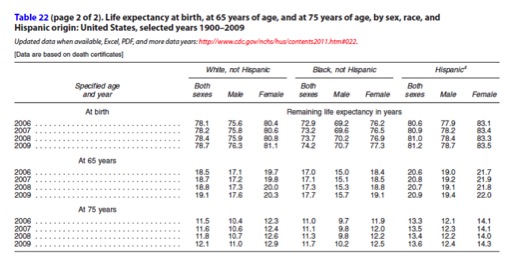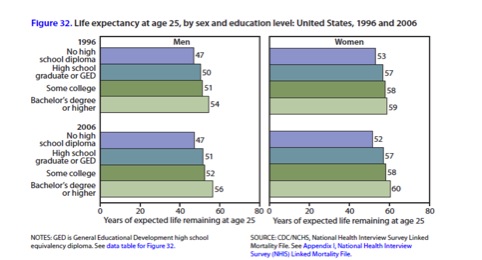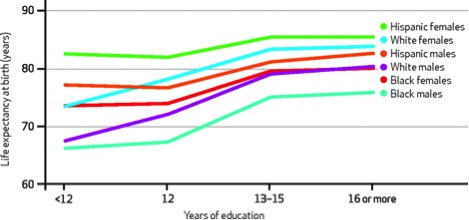Longevity and the Retirement Age
Much of the long term pressure on the finances of the Federal Government is being driven by rising expenditures on health care and pensions and much of this is being driven in turn by an aging population. This has led to proposals to raise the retirement age especially for Medicare. You will likely be hearing more about the retirement age as our political “leaders” try to figure out what to do next in terms of taxes and spending.
Here is a proposal from the conservative Heritage Foundation on this topic, but they are not alone and many “centrist” groups are proposing increases in the retirement age for Medicare. This idea has been criticized by people like the economist turned political commentator Paul Krugman as unfair because the increases in overall longevity in the U.S. have been uneven and not shared by all socioeconomic and racial subgroups in the country. Today I want to take a deeper data driven dive into this topic.
1. The big picture. In an earlier post on longevity I pointed out that in 1960 about 60% of men and 71% of women lived to age 65. The men who made it to 65 then lived an average of about 13 years and the women who made it to 65 lived another 17 years. In 2010 about 84% of men and 89% of women made it to 65. The average man who makes it to 65 now lives another 16-17 years and for women it is about 19 years. These changes are being amplified by the fact that the leading edge of the baby boom generation is reaching retirement age causing a further bulge in the aging population. You don’t have to be a rocket scientist to realize these demographic trends are putting pressure on Federal finances.
2. Differential Increases in Longevity and Socioeconomic Status. I mentioned above that critics of the idea of raising the retirement age for Medicare point out that most of the gains in longevity have been in people that are relatively well off. The graph below is from a study by the Social Security Administration and shows survival curves starting at age 60 for men comparing those born in 1912 with those born in the 1941. The key observations are that: a)in 1912 there was not much difference in life expectancy between the top and bottom half of income distribution, b) the bottom half of the 1941 cohort does not look that different than either group from 1912, and c) that life expectancy at age 60 has really gone up for the better off men born in 1941. There are lots of ways to slice and dice data like this but pretty much every way you do it comes out the same and gains in life expectancy have been greater for people who are better off.
3) The race and education snapshot. Below are a table and graph from summary data from the U.S. Centers for Disease Control in 2011. The table shows life expectancy at birth, 65, and 75 in recent years. What is interesting here is that the differences in life expectancy between Blacks and Whites at 65 and especially 75 are much lower than the projected differences at birth. The other interesting thing to note is that Hispanics are higher than either Blacks or Whites in all of the major comparisons. I interpret this in a couple of ways. First, a big issue here is not what happens once people reach the standard retirement age of 65, but what is happening prior to age 65 especially in Blacks. The other issue here is that women do better than men and I have not heard any of commentators claim that raising the retirement is unfair to men.
The next figure shows life expectancy at age 25 in 1996 and 2006 by education level and sex. This table shows a couple of things including: a) educated people live longer and there is a dose response curve, and b) life expectancy at age 25 for less educated people has stagnated. This figure also shows that women live longer than men at every level of education.
4) A summary slide. The figure below is a summary slide that shows the effects of race, sex, and education on life expectancy at birth. These differences would likely exist at age 65 but be much smaller in terms of absolute years. The article this figure was taken from indicates that some of these differences might be getting worse.
My take on all of this data. There are all sorts of ways this data can be analyzed. For the purposes of thinking about the retirement age a couple of things stand out.
- People as a whole are living longer but the gains have been uneven and influenced by sex, education, and race. There are also probably pretty tight relationships between race, economic well-being and education.
- A lot of the problem is not about what happens when people reach age 65, but what happens before age 65. People with lower socioeconomic status tend to have a host of behavior and risk factor issues that negatively influence their ability to make it to 65 and then do as well after age 65. So the real issue here is how to address health disparities vs. the fairness of raising the retirement age.
- Many of the factors leading to health disparities like differential smoking rates, obesity, lack of physical activity, and violence have little to do with what we think of as traditional health care and will not be fixed if and when high quality health care is available to all.
- There is also an argument that people are retiring too early for economic reasons and that a lot of people are financially unprepared for the long life they are likely to live in retirement. If raising the eligibility age for Medicare encourages people to work longer, maybe that is good for their own long term economic well-being as well as that of the country as a whole.
Closing comments. The discussion about the fairness of raising the retirement age for Medicare has been marked by incomplete thinking about the data and is confusing the very real problem of what to do about health disparities based on race, education, and sex with the arithmetic of Federal finances. Some of this discussion is being led by people with overtly political and personal agendas like Paul Krugman (who should know better) at the expense of a hard look at the facts.
This entry was posted on Thursday, January 3rd, 2013 at 6:00 am and is filed under Current Events, Health Policy. You can follow any responses to this entry through the RSS 2.0 feed. You can leave a response, or trackback from your own site.






January 10th, 2013 at 6:32 am
Bait & Switch: Longevity and the Medicare Eligibility Age | Human Limits: Michael J. Joyner, M.D. says:[…] a post last week I reviewed data on life expectancy and implications for the retirement age especially in the […]
February 25th, 2013 at 11:25 am
It is impossible to change the numbers for people over some age,25-50. Therefore, if the pre 65 lifestyle determination cannot be changed, the SS and more importantly Medicare eligibility should not be set higher.
March 4th, 2013 at 6:04 am
Medicare’s 2 for 1 Challenge! | Human Limits: Michael J. Joyner, M.D. says:[…] want to get back to issues associated with Medicare in specific and the demographics of aging in general. Part of the reason for this is that the rate of increase in Medicare spending […]